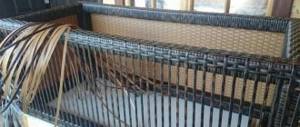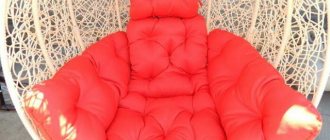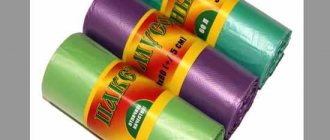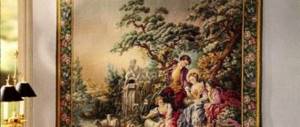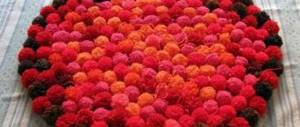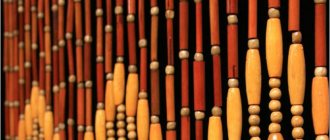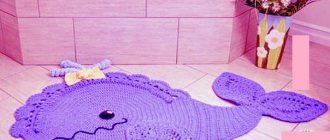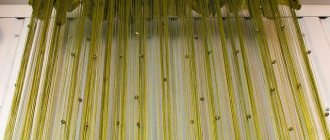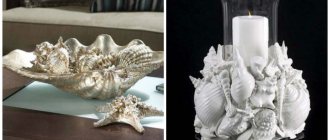Panels and curtains using macrame technique. Ideas, master classes
I have already said more than once that the macrame technique has been completely undeservedly forgotten by modern needlewomen; few people use it in our country and it is more often used to create jewelry. But I want to show you what wonderful possibilities the macrame technique opens up for creating interior objects - panels and curtains. I really hope that the above ideas and master classes will inspire you to master the wonderful multifaceted technique of macrame and create your own home masterpieces. And who knows, maybe this very creativity will become your profitable business in the future, why not :)
Enjoy watching!
And some useful information
Although winter still won’t come this year, you shouldn’t risk your life and health by continuing to drive your car with summer tires - as my personal experience shows, frost, snow and ice happen very suddenly, and at this moment all tire shops are clogged the same “conscious” drivers :) Therefore, it is worth taking care of changing shoes in advance. If your winter tires cause you doubts about the quality or you have been driving them for a long time, it makes sense to purchase new ones and I recommend doing so in the specialized online auto goods store ShinaDiski - https://www.shinadiski.com.ua/zimnie_shiny.html, It is unlikely that you will find such a wide range of products at more than adequate prices. Take advantage and let winter roads bring you only positive emotions!
Master class on creating a wall panel from craftswoman Geneva (apairandasparediy.com)
A 60 m clothesline and wooden beads were used for the work.
We fix the wooden holder for the panel
We cut: 16 ropes of 3.5 each and prepare one rope for hanging. Fold the ropes in half and tie them to the holder. Don’t forget to tie a rope in the middle for hanging - this rope will not take part in weaving.
Next we weave a fixing row
Now, starting from the left side, tie the threads diagonally with knots.
In some places we string wooden beads onto the ropes
Next, we tie four ropes each as follows:
We repeat again
And again we knit knots diagonally
At the end of the work, we tie four ropes with double knots, untwist the ends, and cut off the excess.
And add a little color
Result:
Master class on making curtains using the macrame technique from Emma Chapman (abeautifulmess.com)
Formation of nodes
Master class on weaving panels with knitted stripes from Roxy Tagawain (brit.co)
The author independently made “yarn” for weaving by cutting knitted fabric into strips
Panel with amber effect from craftswoman Sam (bloglovin.com)
Master class on making panels from Corinna (formyloveof.net)
The work also used metal tubes and bamboo painted with gold paint.
And a panel from Moria Seal (blog.homedepot.com)
The macrame technique is very versatile and multifaceted; it allows you to create a huge number of interesting things for the home. Master the technique and let macrame creativity bring you pleasure!
I wish everyone a positive day and a great mood!
Source
sam.mirtesen.ru
Macrame in the interior: photos and patterns of weaving Macrame panels on the wall with your own hands
It’s easy to get confused in the huge amount of information on how to weave a Macrame panel on a wall with your own hands. We will help you systematize this knowledge, teach you how to read Macrame weaving patterns and create a panel sketch yourself. We will introduce you to several master classes on making panels for beginners and not only, and also show examples of using Macrame in the interior.
Examples of Macrame panels on the wall
There are many examples of the use of wicker panels in interiors. Notice how beautiful and modern they look.
Panel with an antique twist
Pretentious and delicate baroque
Strict modern
Very often there are panels not only rectangular, square, but also round in shape.
Weaving panels in the Macrame style is one of the areas of textile weaving.
Panels can and should be not only aesthetic, but also functional. The prototype of ancient military banners is a panel with a pentagon-shaped pocket. This is the simplest option, but sometimes more complex products are found. This panel can be used to decorate the kitchen, and the pocket can be used to store spices and seasonings.
In the bedroom, an original decoration will be a panel on the wall near the bed, which will add zest to the interior of the room.
A very popular panel is still the beloved owl, as a symbol of wisdom and good luck.
What material is needed to weave panels using the Macrame technique? Everything that is used for weaving and other products using this technique, and this is:
- hemp, linen, paper ropes;
- flat braid;
- cotton threads.
The material is selected so that it is convenient for the master to work and the knots are clear and beautiful.
It’s worth mentioning right away that there are no patterns for weaving Macrame panels as such. The main thing in this product is the primary sketch. As a basis for it, you can take not only a painting, an image, but also a mosaic, an ornament, or simply a certain theme.
To create a sketch, a simple selection of a beautiful combination of weaving knots will do.
You can also use photographs of already created panels to navigate them and create your own.
A Christmas tree and a snowflake are the theme of New Year's macrame, and flowers are the theme of summer. In the fall, a herbarium of beautiful leaves will inspire creativity.
To make a sketch, you can learn to use graphic editors such as Photoshop, Corel Draw, GIMP. You can create a unique panel design on paper using imagination and simple Macrame knots.
Whatever pattern you choose, you must strictly observe the sequence of weaving and the accuracy of all Macrame knots. After all, a product made clearly and slowly will become a decoration of the home and the pride of the one who created it.
An example of one of the patterns applicable for weaving panels is a border of rhombuses made with grosgrain knots:
In what interior styles will Macrame panels be relevant? Since this art came to us from the ancient East, the decor will be most harmonious in oriental interior styles.
It will look no less successful in a room decorated in Boho style.
Boho style panel
One more thing
In romantic interiors:
Tender romance
Brighter decor
And white and beige products will look great in the Scandinavian style.
Snow-white minimalism
Scandinavian eco-style
Peace and freedom
And perhaps, over time, Macrame will become a profitable business for you, because now panels using the Macrame technique are successfully sold at various fairs and online sites for selling hand-made goods.
Look how diverse and beautiful the world of Macrame is!
We will introduce you to the sequence of making a simple Macrame panel on the wall with your own hands. The work is easy, and the result is amazing.
We will need 60 m of clothesline and several wooden beads to decorate the product.
We fix the holder for the panel.
We cut the rope into 16 pieces of 3.5 m each. We fold it in the middle and tie it to the bar, securing the rope with a knot in front. Don’t forget to tie one short rope to the bar for hanging. She will not take part in the weaving.
The first row is fixing. Attach the thread to the bar.
The horizontal brid is ready.
Then, starting from the left side, we knit the bridge diagonally with grosgrain knots.
Sometimes we add beads as desired by stringing them onto ropes.
Next, we tie 4 ropes with these knots.
Knot knitting pattern
Complete series
Repeat 2 more times.
And again we knit knots diagonally, but from right to left.
At the end of the work we weave simple double flat knots on 4 threads, gradually increasing their number.
To make the panel look brighter, add a little paint!
A little color...
...never hurts!
The work is done. We make a mount and hang our Macrame panel on the wall. And we admire the result!
Macrame panel owl (step-by-step master class)
(Translation by Diana Silantieva)
Starting this work, you must learn how to perform the following Macrame knots:
Material for work
- 10 m of regular cotton thread No. 10;
- two beads for eyes;
- two small wooden sticks;
- brush and wood-colored paint for painting;
- PVA glue;
- electrical tape for attaching the work to the work surface.
First stage. Attaching the thread
Cut the thread into 10 pieces of 1 m each. Attach with a knot on the front side of the work to a stick. Secure the ends of the stick to the work surface with electrical tape.
Second phase. Weaving the top of the head
We weave a “chessboard” of double flat knots on 8 middle threads, grabbing a pair of threads from the outermost knot of the previous row on each side.
Working with the first two strands, using them as a warp, make loop knots, alternately working each of the next 8 strands.
It is necessary that the “bulge” of the knot is on the front side of the product.
Repeat exactly the same on the right side of the owl. The nodes should be a mirror image of the left side.
Third stage. Beak weaving
The owl's beak is made on four central threads. We weave a chain of 4 flat knots. Next, you need to apply glue to the tips of the fourth threads on both sides. When the glue has dried, trim the ends of the threads at a slight angle. String one bead on each of these two strands.
Bend the chain of double flat knots so that it bends forward. Then make a berry knot. The beak is ready.
To prevent the owl from sagging on the sides, be careful when weaving further.
We continue working from the center, using threads No. 9 and No. 10 (previously used for the beak) as warp threads, we make loop knots, alternately working with threads from the left. Make loop knots so that the “bulge” of the knots is located on the wrong side of the product. Do the same on the other side, only in a mirror image, using threads No. 11 and No. 12 as main threads.
It is important! Be sure to adjust the thread tension so that they do not sag. This will make the owl's head look neat.
Then we weave a “chessboard” of double flat knots, adding two threads on each side in each subsequent row. The owl's head is ready.
Fifth stage. We weave the wings of an owl
We form a chain of 6 double flat knots on the outermost 4 threads on the left. Do the same on the four outermost threads on the right.
We weave a “checkerboard” of double flat knots on 12 medium threads. Repeat weaving 3 times (6 rows of chess in total).
Connect the owl's wings to the body by tying one row of double flat knots, grabbing pairs of threads from the two chains of knots that make up the wings. We weave another row of chess.
In the center of the owl’s body, using threads Nos. 7–10 and threads Nos. 11–14, we make two double flat knots.
Next, we make knots near the second stick, using threads Nos. 6, 5, 4, 3. Repeat the same action using threads Nos. 15, 16, 17, 18. These loop knots form claws, and the stick will serve as a pole.
Using all 20 strands, tie a row of double flat knots.
Seventh stage. Knitting an owl's tail
We weave the tail with a checkerboard pattern of double flat knots, grabbing one pair of threads on each side as we weave.
Eighth stage. Owl decoration
When you're done, steam the owl. Paint the sticks if desired, moving the owl to the side. Cut the threads parallel to the tail at an angle.
You can also weave large round eyes separately, paint them emerald and sew them to the main fabric. And instead of pupils you can use black buttons.
Svetlana Dvornikova shows the entire process of weaving the “Owl” panel in 2 parts:
To further help you understand how to weave Macrame panels with your own hands, we would like to introduce you to some video tutorials on this topic.
Boho style panels are woven by Lyubov Lopantseva:
Simple stylish decoration from Marusya DIY:
Asya Woo shares small and affordable ideas for wall decor and a master class on creating panels in a decorative ring:
So, to make panels using the Macrame technique you need attention, imagination, patience and strict adherence to instructions for weaving knots. Compliance with these conditions is a guarantee of excellent results! Good luck!
Author of the article: Lyudmila Sontseva
YOU WOULD BE INTERESTED
Flower pots using Macrame technique: weaving patterns and master classes for beginners
For everyone who shares it with friends, “Cross” guarantees a creative takeoff for the whole year! 
nacrestike.ru
Macrame weaving patterns for panels and bags with pockets
Beautiful products can now be created from synthetic materials
Among the various types of applied arts, the art of macrame is one of the oldest. The history of this unusual craft originates in the East, in Ancient Egypt, China and Japan. Even the ancient Incas had a developed system of knotted writing, the mystery of whose messages is still being tried by scientists all over the world. Gradually, the art of filigree weaving developed, acquiring an army of fans on all continents. The basis of needlework is the ability to knit beautiful knot combinations, which were transformed into skillful products by the skillful hands of craftsmen. A new generation of needlewomen has breathed new life, creating new forms, inventing new beautiful combinations, offering unique design solutions. For beginners in macrame creativity, weaving patterns are the main auxiliary tool, after mastering which you can easily create openwork products.
Materials for work
Today it is difficult to answer who was the discoverer of the unusual weaving method, but the whole world is grateful to him. The uniqueness of knot weaving lies in its simplicity, beauty and budget. To weave beautiful interior hand made items and accessories, such as panels, owls and other amazing crafts, you will need very little. First you need to determine the base and choose the material for weaving.
Before choosing the necessary colors and material, you need to decide on the theme.
Most often used for work:
- hemp or linen ropes;
- cotton cords and twine;
- sisal and any flat braid.
In ancient times, products using the macrame technique were made from leather cords, straw and even plant fibers. Modern materials will surprise even the most experienced craftswomen with their variety. For example, reinforced threads, colored floss, lurex, all kinds of cords and threads with a waxed texture will become the basis for an original and stylish decoration. Centuries-old practice shows that natural materials like flax or cotton are more pliable for knitting textured knotted patterns.
Threads and cords in macrame
It should be remembered that the threads for creating panels, handbags or bracelets using the macrame weaving technique must be as strong, pliable and moderately twisted as possible.
You should not choose threads with a “shaggy” texture for knot weaving. Increased “fluffiness” will hide the unique patterned relief of the product from us. Skillful combination of several types of applied arts, such as embroidery, knitting or crocheting, beading, will create a truly exclusive masterpiece.
Selecting tools
Before starting to study and select macrame patterns, beginners should acquire a “magic chest” that will contain all the necessary tools for creative work. One of the main advantages of such needlework is the minimum financial costs.
If you want to get a clear relief pattern, then the material for weaving macrame needs to be tightly twisted
For weaving you will need the simplest sewing tools:
- safety pins to secure the threads;
- tailor's scissors with a sharp blade;
- sewing needles and threads;
- PVA glue to fasten individual elements of the pattern;
- simple crochet hook.
In addition to a simple sewing kit, you should prepare a work surface. This can be a small pillow that can be easily sewn with your own hands. The pillow can be replaced with a board, which is upholstered with foam rubber and then tightly covered with cloth. Such a simple device will prevent the threads from getting tangled and will provide the craftswoman with comfort during the weaving process.
After the pattern of macrame products has been selected, threads or rope are fixed to the surface, and the components are carefully laid out in the desired order.
Master classes
Weaving with threads is fun and interesting. Experience is valuable in any job. These skills will allow you to make elegant wall panels, original crafts, beautiful bedspreads, macrame napkins or curtains.
Original crafts
You can also weave stylish accessories, jewelry, bags and anything that your imagination tells you.
Wicker jewelry
To master macrame for beginners, all you need to do is choose high-quality material, get in a creative mood and get acquainted with detailed master classes from experienced craftsmen.
Original panel "owl"
A panel in the shape of an owl is an original decoration for any interior style that will emphasize the warmth and comfort of the family hearth. Interestingly, the wise bird in the house is the protector of prosperity.
One of the main elements of woven patterns are all kinds of chains
According to the teachings of Feng Shui, owls protect the home from evil. The most popular of all macrame products is a panel in the shape of an owl. To make it, we will need strong and thick threads in a skein 10 meters long, two round sticks, paints and a brush, two beads and PVA glue.
If during the weaving process the thread suddenly runs out, do not despair. We tie a new thread, tying the two ends with a knot on the wrong side of the product.
The weaving algorithm is as follows:
- Divide the length into ten equal segments 1 meter long. We secure them to the stick with a simple loop knot, resulting in 20 working threads.
- We secure the stick on the table with electrical tape to make it easier to weave the pattern. We carry out weaving according to the pattern, starting from the frontal part.
- We weave knots using the simplest checkerboard pattern. The result should be a triangular-shaped canvas.
- Separately we weave the bird's eyes. From the first two threads on the right we knit a right-handed loop knot, repeat the element with two adjacent ropes and continue like this until the end, edging the right eye. We repeat the process in a similar way, but using left-sided loop knots. Sew beads into the middle.
- The bird's beak is woven from four central threads, weaving them alternately into flat double knots.
- We continue weaving with a checkerboard pattern in five rows.
- To tie the wings, we use four components on each side, braiding them with double-sided knots. After this, we return to the “checkerboard” pattern again, connecting it with the wings.
- Next, we place the next stick, which will be a perch, and thread threads numbered 3,4,5,6, as well as from 15 to 18, onto it. We get the bird’s legs.
- Next, we complete the pattern according to the diagram, and at the end we cut the threads diagonally.
An exquisite and original panel, made by the hands of a talented craftsman, will warm you with warmth and decorate your interior.
Weaving the “owl” panel, part 1
Weaving the “owl” panel, part 2
We weave a handbag organizer
An original wall organizer in the form of a bag will help not only decorate the interior of the hallway, but also collect all the necessary little things, such as keys, a comb or gloves, in one place.
Each type of knot requires a certain length of thread.
The knitting algorithm is as follows:
- For work, we take a thick cotton rope 40 meters long, a round stick made of wood or plastic. You can take threads of two colors to separate the base from the pocket.
- We divide the rope by cutting it into 20 equal components. We divide yarn of a different color into 12 parts, each 1 meter long.
- We fix 20 components on a stick using the classic knot fastening method. We begin the weaving process, strictly adhering to the diagram in the figure.
- We knit the first five rows with square knots, braiding the mesh. We move on to weaving a pattern in the form of small rhombuses. 12 threads are involved in the work. We connect the diamonds together with a knotted chain.
- The pattern of diamonds and a grid of square knots are arranged in a checkerboard pattern.
- Let's start creating the pocket. Separately, we knit a mesh of square knots. The pocket is slightly smaller in size than the base itself.
- Use a sewing needle to sew together the two parts of the product. We weave a strap on top to hang the organizer on the wall.
A similar pattern can be used to create an elegant summer handbag that will ideally complement a fashionable look.
This elegant, openwork macramé bag will complement your outfit.
The art of macrame is a universal type of needlework. Having mastered the simplest basics of weaving, learned to read diagrams and select high-quality materials for work, you can safely experiment.
Charming macrame bags
A wonderful gift would be hand-made openwork pots for indoor flowers, wicker lampshades, macrame napkins and tablecloths, as well as fashion accessories.
Might be interesting
samrukamy.ru
Wonderful macrame panel: weaving patterns and 30 photos
A wicker product using the macrame technique creates an atmosphere of warmth and comfort in a bedroom or children's room. Macrame, photos and patterns of weaving panels, which can be easily found in needlework magazines, involves the creation of beautiful knotted installations from dense knitting. It is believed that the pioneers of this artistic technique were the ancient Egyptians, who used this method to decorate the mansions of the pharaohs. But historians have discovered similar decorations among the Greeks, Assyria, Peru, and China. That is, it is impossible to say exactly who was the first to use macrame to create an artistic plexus and decorate the interior and facade. However, now they even create panels from it.
Content:
Weaving panels in the style of macrame is a subtype of textile art. It is suitable for both beginning craftsmen and experienced hand-made representatives. It is believed that such crafts first began to be made in the early 60s in England, but this is not an entirely correct statement.
What are compositions made of?
The main materials for creating macrame panels are:
- Hemp rope;
- Linen rope;
- Paper rope;
- Cotton;
- Flat braid
- Sisal.
Most often, thin ropes made from natural fibers are used for weaving using the macrame technique.
Naturally, the use of other fabrics and strands is also allowed, but it must be taken into account that the main thing in the technique is the creation of loops. That is, the material is selected such that it will be convenient for the master to work with, taking into account his knitting skills.
Macrame for beginners: patterns for weaving panels
It’s worth mentioning right away that there are no schemes or algorithms for creating macrame under panels as such. The main thing in the work is the primary sketch. To create it, both a simple cutting pattern and a contour pattern are suitable. You can even use photos of already created panels posted on the World Wide Web and navigate by them.
If you plan to create volumetric macrame, then it is generally recommended to use a foam base. If lampshades are needed, you can add simple metal rings to the final product, which will hold the basic shape of the macrame. And the knots are made in any convenient way.
That is, you can use any knitting technology, including:
- Through the hook;
- Patchwork (where the loops are connected diagonally);
- Bachmann knot.
There are many weaving techniques in macrame, which gives limitless scope for the manifestation of creative potential.
These are the main methods that are most often used, but it is allowed to include any others in macrame.
Functionality in the interior: macrame wall panel with pockets
Macrame wall panels with pockets are a kind of prototype of old military banners. This means that a similar shape is given by a broken 5-gon. This is the simplest option, but exceptions are allowed. Such a panel can be hung on the wall, and the pocket itself can be used, for example, to store spices and jars of seasonings in the kitchen or any other small items that should always be at hand.
To create this macrame you will need:
- Clamps (to create the original shape);
- Rope;
- The simplest scheme;
- Knitting needles (professionals can do without them, but for beginners this is not an option).
At the top of such a panel, a fastening is made for a regular nail. A kind of “handle” of 1-3 twists of the rope.
Decor and macrame: panels for wall clocks and paintings
Macrame panels can also be made specifically for watches. That is, a knitted product is created that is attached to a watch. It is not necessary to create pockets, just like a frame.
The knot weaving technique is used to create a variety of interior decoration items: tablecloths, bedspreads, lampshades
In this case, it is advisable to make macrame round (although you can also start from the shape of the clock). By the way, it is believed that the best way for this case is to use Josephine knots from a thick strand.
Since the panel will be placed behind the clock, it will have the style of lambrequins, that is, a beautiful flowing lampshade.
You can add such a panel using:
- Garter;
- Longitudinal weaving;
- Woven folds (through which, like a web, ropes are laid).
The owl represents wisdom and calm. Accordingly, when creating such macrame, you should choose simple, calm tones. The ideal choice is beige and brown. The owl itself should be woven from the middle. The head, wings, legs - all this is done separately and then connected with diagonal knots (if the weaving was done from the center).
Step by step it looks like this:
- Knitting the base (the body of the future owl);
- Creation of other elements;
- Adding eyes, ears (just loose rope);
- Compound.
The “Owl” panel using the macrame technique is not just a decoration, but an integral part of the interior
Of course, many can show a master class and create such a panel from one element, but this is no longer for beginners - it will be too difficult and the product can be damaged by improperly tightening even one knot, which will result in an arrow.
Sketch for a macrame panel: tutorial on how to create
Yes, the most difficult thing in creating macrame is the sketch. But you can take as a basis not only some painting or image, but also abstraction, ornament, mosaic and just patchwork - a patchwork connection. You can focus on a specific topic. For example, New Year's macrame is the same snowman or snowflakes, summer - some flowers or forget-me-nots. And in the fall, you can even use a herbarium of leaves as a sketch.
When planning a product you need to consider:
- It is allowed to use jewelry, beads and even coins (you get something like a mandala);
- Knitting can be done not from ropes, but from lace belts. These, by the way, are sold in textile stores;
- It is better to starch the finished product made of fine textiles.
Macrame training course (video)
As for sketches, there will be no problems with them at all if you learn to use applications such as Photoshop, Corel Draw, GIMP. Macrame is a fascinating creativity that gives birth to masterpieces, but requires attention and perseverance. With the help of imagination and visual materials, you can make a unique design with your own hands.
Happy ideas and implementations!
Macrame products (photo)
homeli.ru
scheme. Macrame weaving for beginners
Macrame is one of the most popular types of needlework, which is based on weaving various knots. The macrame technique is used to make various wall panels, flowerpots, lampshades, women's jewelry, curtains, chair covers, napkins with geometric patterns, and so on.
Materials
Weaving macrame is not easy work that requires special attention and patience. Not all beginners know what materials are best to use for the macrame technique. Schemes for beginners will help you figure out how to weave a beautiful thing step by step. First you need to choose a non-slip thread, for example, cotton or thick clothesline.
To make jewelry and clothing accessories, floss, linen, woolen threads, lurex, and iris are used. Things that are made of leather cut into thin strips look very interesting.
Products using macrame technique
Interior decorations are woven from thick threads: ropes, cords, synthetic threads, fishing line. Variegated threads are not suitable for macrame; they look unclear. An excellent addition to such needlework can be using beads, seed beads, wooden rings, balls, and sticks.
The product will hold its shape better if you use thin wire, maybe colored. First, a frame is prepared from wire, and then threads are hung on it. Many girls and women are interested in the question of how to weave macrame.
On a note
When working with silk threads or twine, you need to moisturize your fingers. It is necessary to wear fabric gloves when braiding rigid ropes. It is better to boil hard natural threads before use - they will be softer and more elastic.
Silk threads unravel during work; to make it easier to weave from them, you need to lubricate them with glue or tie knots, and in synthetic ones, melt the ends over a fire.
When preliminary calculating the material consumption, you need to remember that the working thread becomes 4 times shorter when tying knots, when weaving with double flat knots - 6-8 times, when weaving a mesh - 3-3.5 times.
What is needed for weaving macrame
When working with thin threads, you need a pad that is filled with sifted sand or foam rubber and covered with soft fabric. For beginners, you can use the soft seat of an old chair, a foam board, as well as a wooden board (20*45, 20*35, 15*30 cm), on which 6-8 cm thick cotton wool or a layer of foam rubber is placed and then covered with fabric.
For such work you also need scissors, decorative pins, PVA glue, “Moment”, needles with a large eye.
ABC of macrame
First you need to learn the names of the threads that are used in macrame. The weaving pattern is not complicated if you know some techniques.
Carrier thread - in macrame, this is the thread on which all the threads for this product are hung. Knotted thread or warp - knots are woven around it. It must be pulled tight, otherwise the knot will not work. Working thread - knots are tied from it around the warp, its length should be 30 cm. Additional thread - additionally woven into the product, despite all those previously hung.
Methods of attaching threads
If you want to get into macrame, the weaving patterns are described in detail below.
Front fastening of threads with a lock. Fold the working thread in half and lower it behind the warp, loop down. The resulting two ends of the thread are lowered down onto the warp and into the loop. The horizontal bar of the loop should be on the face of the set.
Purl fastening of threads with a lock. The working thread is also folded in half, but brought under the warp with the loop facing up. Then the loop is lowered down onto the base and both ends are passed into it. The loop crossbar will be on the wrong side.
Extended facial thread fastening. The thread is folded in half and secured with a lock on the base on the front side. Then the threads are separated: take the right one, insert it up under the warp, then down onto the warp and into the loop; with the left one repeat the same actions as with the right one. This type of thread fastening is used for a dense row of knots, with no supporting thread visible between them. If you make more turns at each end of the threads, the fastening will be even tighter.
Extended purl fastening of threads with a lock. Fold the working thread in half and fasten it inside out to the base with a clasp. Then the right thread is brought up onto the warp, down under it and into the loop. Do the same with the left.
Uneven thread fastening is used when making a chain. In this case, the working thread decreases 4 times faster than the knot thread.
Main nodes
Hercules' knot. Two 10 cm threads are placed vertically on the pillow, the ends are secured separately with a pin. The right thread is brought under the left, and the left thread is brought from bottom to top and into the loop. Then the knot is tightened.
Knot chain. Take two threads. Alternately, each one is either working or nodular.
Rep knot. It is knitted from left to right and from right to left.
Rep knot from left to right. A knot thread is placed in front of the working thread, the working thread is thrown over the knot thread on the left side and passed onto the knot thread, then the working thread is thrown over the knot thread again, but on the right side, and the end of the thread is pulled through the formed loop. The coils are aligned and tightened. This macrame technique, the diagram of which is described above, can be used to make any interesting thing.
The rep knot is knitted from right to left in a similar way, only first the working thread is thrown to the right and then to the left.
Triple horizontal knot. Using a working thread, a horizontal knot is tied on the knot thread. Then the used thread is placed again on the knotted thread and inserted down into the loop. From such knots you can weave patterns in the form of diamonds and zigzags.
Diagonal rep knot. Take three threads, hang them on a knot and weave a diagonal knot. With your left hand, hold the first knotted thread on the right, placing it diagonally. The second is thrown to the right through the knot and pulled forward, up onto the knot on the left and down into the loop, the knot is tightened. With the third thread, do the same as with the second using the macrame technique (the diagram will help you figure it out).
Double flat or square knot. It is most often woven using 4 threads (2 working and 2 knotted). The leftmost thread is thrown over two knotted ones (they are located in the middle), the right one is passed over the left and then under the knotted ones and pulled out over the left working thread. A left half-knot is formed.
Place the rightmost thread on top of the knotted threads. The left one is on top of the right one, passed under the knotted threads and brought out on top of the right thread. A right half-knot has formed.
From two such half-knots, a double flat knot is obtained, and by repeating the half-knot, a twisted cord can be obtained.
Chess. By tying double flat knots in rows and leaving space between them, you can get a checkerboard pattern.
Macrame weaving also involves a number of auxiliary knots: simple, horizontal knot, cross-arm knot, tatting, Chinese, capuchin, tie and Armenian.
Beginning of work
Before you start working with macrame, you need to hang the working threads on a knotted thread. There are many different hanging methods:
Braided ring. In order to make a sample, you will need only 10 threads: one thread one meter long, two 1.6 meters long, three 0.3 meters long, four 0.15 meters long. One thread should be laid vertically on the pillow and pinned in the middle. From the center in each direction you need to set aside 10 cm.
The second thread should be carefully folded in half and applied from the wrong side to the middle part of the first thread. Next, you need to weave a chain of square knots 20 cm long. The chain needs to be folded in half, the ends of the first thread connected together. After this, you should tie a flat knot in the following sequence: second - first - second.
Next, you need to secure the threads using the “trap” technique. The last thread should be folded in half and laid with the loop down. The third thread needs to be wrapped around the first thread, 7-9 turns should be made. After this, you need to pull out the loop at the two ends located on top.
Macrame: master class
In order to make a beautiful thing, you will need a frame from an old lampshade; it must first be covered with new fabric. How to weave macrame for a lampshade?
You need to take a rope with a diameter of approximately 3 mm and cut the threads 6 times longer than the lampshade itself. The threads should be folded in half and hung with an extended purl fastening on an additional thread, which is equal in circumference to the upper part.
The threads should be distributed into groups of 4 each and weave flat chains of three double flat knots. It is necessary to weave all the ends of the chains onto the horizontal thread with rep knots - now a border has been formed.
In order to weave the central part of the lampshade, the ends should be distributed in this way: 12 ends each for fragments of double flat knots. The four middle threads must be woven into flat chains. Josephine knots are placed on bundles of loose threads under diagonal bridles.
The lower part of the lampshade should be woven in a mirror image. The ends that remain must be secured using the macrame technique. The lampshade weaving pattern will help you do the job correctly and competently. This beautiful original lampshade is ready to use!
fb.ru
Making macrame: photos and patterns of weaving panels
Knot weaving has been known for a long time, since the times of Rus'. Now this method of weaving is quite popular among designers. A variety of weaving and knitting techniques have long been very popular among needlewomen. Today, the art of creating amazing images using macrame will allow you to decorate your home in an original and beautiful way, bringing a special atmosphere to it.
Content:
Knotted weaving, which replaced the usual knotless weaving, is commonly called macrame. Translated from Arabic, this term means “fringe”, as well as “lace”.
Modern needlewomen, using a special pattern, weave interesting details for clothes with their own hands or create comfortable and unique covers for household items. Such decorative items can be woven using different materials. Linen ropes, regular threads or decorated with gold threads, as well as floss and silk are well suited for this.
The most popular material among macrame lovers is linen. Quite often artificial dyes are used to make the future product look bright
However, for high-quality jewelry making, the macrame knots must be tight, this allows you to create a clear, correct relief and pattern.
The macrame technique has found its admirers due to its ease of use. Such weaving will not be an insurmountable problem even for beginners. It is enough to strictly follow the MK (master class) and an excellent result is guaranteed.
Macrame training course (video)
Master class: macrame panels for beginners
Having decided to try macrame weaving, you should initially pay attention to the selection of materials. This kind of creativity is distinguished by the fact that improvised materials are suitable for creating the product, and the main tool will be your own hands.
Having selected the necessary pattern, all that remains is to select threads or ropes (they can be anything - silk, wool or some other), after which it is important to follow the instructions step by step, this will ensure the successful creation of the panel.
In order for the material to be durable, it should be boiled for 15 minutes.
When weaving panels, beginners should remember that for the correct macrame technology, it is necessary to attach the main thread to the working surface; it will not participate in weaving, but instead, all working threads must subsequently be attached to it.
You can make New Year's toys from macrame: even a child can handle this work
There are several knots that you need to remember to master the macrame technique:
- Flat right-handed knot. Here two threads are attached to the bar to make 4 ends. The warp will be 2 and 3 threads, the workers 1 and 4. The fourth thread must be placed on the warp, and the first one is passed under the warp and pulled from below into a loop.
- Flat left-handed knot. Here the weaving technique is similar to the previous type, but instead of 4 threads, you need to start working with the first one.
- Square knot. It is considered the main knot in macrame. To create it you need to weave both of the above knots. You should start with the right side.
- "Chameleon". In this weaving technique, the working threads are constantly changing. Having weaved a square knot, you need to swap the main threads with the working ones and make another square knot.
- “Tatting.” It is woven from 2 or 4 threads. Using two threads - the first is placed on the base, which is wrapped with 3 threads from top to bottom and pulled into the resulting loop. Then the first thread is brought under the warp and pulled into the loop from bottom to top. If 4 threads are used, 1 and 4 will be working threads, and the rest will be the warp. First, a knot is woven using 4 threads, and then changed to the first one. You need to weave a chain constantly changing the threads. This round weave will create the desired look.
Options for macrame panels: weaving patterns
Today there are many options for making panels. Moreover, all the diagrams explain in detail how to create an interesting product.
A self-created panel with a pocket will be an excellent decoration for the kitchen or living room. This macrame is not only an interesting interior detail, but will be an excellent solution for storing all sorts of small items. Using the pattern for making such pockets, you can quickly and beautifully weave a unique panel.
A panel made using the macrame technique is perfect for a living room or kitchen
For those who want to update their interior and decorate, for example, paintings, a wicker panel “Forget-me-nots” would be a good solution.
Special diagrams will help you correctly make the frame and the flowers themselves.
Many needlewomen prefer to make New Year's gifts themselves. An interesting and beautiful solution would be a wicker New Year's panel in the shape of a Christmas tree, or other souvenirs of a similar theme.
In addition to the panel options described above, products depicting birds, animals or flowers are very popular. This can be macrame, which depicts an owl, fish and various wall products.
Whatever option of macrame is chosen, the main condition for correct weaving is the strict execution of all instructions for the chosen pattern of the product. Careful and unhurried work will help you create an excellent panel that will decorate the room and be the pride of the needlewoman.
How to make a panel for a wall clock
Using a special pattern, you can independently create an interesting panel to decorate a wall clock. This will help update and decorate even out-of-fashion items.
You will need a bar 5 cm wider than the clock and a cotton rope. To begin with, 20 threads (each approximately 5 m) are cut, which are attached to the bar. You need to make 2 zigzag horizontal bridges (bases).
Decorating the interior with embroidery is quite a fashionable trend. The panel for the wall clock will fit into both a classic interior and a modern Art Nouveau style
The pattern is made on 16 threads (on the left), counting 8 threads for the warp, 7 threads are tied onto it with rep knots. Another brid - 9th thread on the left, weaving is done with rep knots to form the top of a rhombus. Underneath it, 14 threads are woven into a flat double knot. And the lower part of the diamond is formed.
On another brid (2) 5 threads from the brid described above are tied. To the 3rd base 4 knots are imposed, to 4 - already 3, and so on until 6, where there should be 1 knot. The 6th and 7th basics are performed in a similar way. After this, you should separate 2 threads in different directions in the middle, 7 threads are woven onto each. The same pattern is made on the right side.
In the middle of the macrame weave, where there are 8 free threads, you can make two chains of 11 cm each.
To prepare a place for fastening the watch, you need to distribute 4 threads on 2 horizontal bridges. Their length is 15 cm and they are woven in a checkerboard pattern with double flat knots. Each outer thread is tilted towards the middle and 19 threads are woven there.
You need to make chains from the 2 outer threads on each side. The length of the first should be 11 cm, the next one is shortened to 8 cm, then 6 cm. After creating the last chain, two threads are left free, and the length of the next one will be 4 cm.
All 40 threads are woven into the additional thread (horizontal) using rep knots. Then they should be divided into 10 chains (4 threads each) and make 3 double flat knots in each. All that remains is to decorate the side parts of the panel with hemstitching, and tie their ends into one bundle, and then beautifully attach it to the brids.
Macrame: pattern for panels (video)
So, to make a macrame panel you need a little patience, attention and strict adherence to all weaving instructions. Compliance with these conditions guarantees an excellent result, which will become the pride of the needlewoman.
Examples of macrame panels (photo)
Attention, TODAY only!
kitchenremont.ru
description of the checkerboard, pocket with a pattern, mesh and photo of the napkin, cords and bookmarks, detailed
Using the macrame technique, you can create beautiful and original products. Weaving each product using the macrame technique begins with a diagram. You can come up with it yourself or look it up in books or on the Internet. Schemes are presented in the form of a graphic image or verbal description. It is easier for beginners to work with master classes, where, in addition to step-by-step pictures, there is also a detailed story about the progress of the work. Professionals are able to “read” the knitting of a product from a pattern made by another craftsman.
Macrame weaving with diagrams and descriptions
You can weave almost anything using the macrame technique. Furniture, clothing, animal figurines are just a small part of what is made from threads. In any case, to weave even the simplest craft, such as a Christmas tree or a turtle, you will need a clear diagram. It can be taken from books or found in other sources.
Curtain diagrams can be with or without step-by-step descriptions. The first option is good because by following the points of the master class, you will be able to check the woven part of your work with the picture. Using only a diagram is much more difficult since not everyone knows how to read them, but sometimes the author explains before the image which node symbolizes a particular sign.
You can get acquainted with interesting macrame patterns on the Internet or in specialized stores
Schemes consist of one part or several - it depends on the complexity of the product.
Butterflies, fish, Christmas trees, tablecloth, dragonflies, snowflakes, angels, curtains and even earrings are simple products; they use a diagram that even a beginner can read. A voluminous dog, a spider and a cockerel, a clutch, a cradle for a newborn, dresses and sweaters are examples of complex products that need to be assembled from several parts.
A diagram is a very important element in any handicraft; with its help, masters of their craft pass on their experience to beginners. And it is thanks to these pictures depicting the structure of the product that anyone can learn macrame
Macrame element “Chess”
Checkerboard is a macrame element consisting of square knots that are arranged in a checkerboard pattern. Such beautiful patterns are used when weaving fabric for a basket or mesh for the lower circle of a hammock. Square knots are woven from four threads, so the number of threads used to weave a checkerboard must be a multiple of four. When practicing weaving this element, you can use ribbons or thick cords.
The product will turn out to be interesting and unusual if you use the “Chess” element when weaving
Description of the weaving of the “checkerboard” element:
- Attach six threads folded in half to the base. In total you should have 6 groups of 2 threads each.
- Take the first four threads and weave them first into a right-handed flat knot, and then into a left-handed one. Weave the remaining eight strands into square knots.
- In the second row, take the two threads on the left and right to the sides. Weave square knots from the eight threads located between them.
- Knitting the third row begins with a knot consisting of the first four threads on the left (including those that were pulled to the sides in the last row).
- In the next row, the two outermost threads are again pulled to the side, and square knots are woven from the eight remaining threads.
Once you have woven about five rows, you will notice that the square knots are staggered, creating an interesting pattern.
Macrame pattern: Chinese knot
Chinese knots look very intricate and definitely carry some meaning. Sometimes, for the first time, it is difficult to weave knots of this type even if you have a diagram at hand. However, having learned how to perform such elements, you can make even the lightest product unusual, for example, bookmarks and New Year's toys in the form of butterflies, fish, turtles, dogs and roosters.
The loop for hanging Christmas decorations and pockets can be designed in the form of a beautiful Chinese knot, which, among other things, is also a symbol of good luck.
Today, many needlewomen often use the Chinese knot when weaving products.
The knot that you will learn to tie today is called “Luck”. By following the detailed master class, even children will be able to create this element.
We weave together the Chinese knot “Luck”:
- Fold the thread in half and place it on the pillow.
- Take the left end of the thread, step back 4 cm from the bend and bend the thread in this place so that petals 4 cm long are formed on the top and left. Do the same on the right side. You should get a cross with three petals, 4 cm each, and the lower part should consist of 2 ends of the threads and be long enough.
- Take the right petal and place it on top of the top petal.
- Curl the upper petal around the part of the right one lying on it, and place it on top of the left petal.
- With the left petal, go around part of the upper petal lying on it, and place it on the lower threads.
- Using the lower threads, go around part of the left petal and insert their ends into the loop formed after bending the right petal.
- Gently and evenly pull the petals and lower threads in different directions until the knot reaches the desired size.
You should end up with a knot with three large petals on each side. To improve the appearance of the knot, you can pull out three micro petals from the middle.
Macrame pattern of a cat's pocket
Every home has a bunch of little things that don't have their own place. These can be pens, small pieces of paper with the necessary notes, buttons, rolls of ribbons and much, much more. Usually, unsightly boxes are used for storing them. To make the interior of your home more attractive, you can weave your own pocket for small items in the shape of a cat.
Using the macrame technique, you can make a beautiful pocket in the shape of a cat, where you can put various little things
Master class on weaving a cat pocket:
- Prepare 14 pieces of thread. Their length should be 6 times the size of the cat. Please note that the lower part of the cat will be folded and sewn to the upper one. To calculate the length of the threads, you need to determine the size of the finished product, add half the resulting value to it, and then multiply the amount by 6.
- Fasten 13 threads folded in half to one of the threads.
- Weave 7 rows of checkerboard in each row, starting from the second, leaving two new threads hanging freely from each edge. As a result, your seventh row should consist of one square knot located in the center.
- Weave a row of diagonal bridle along the chess board on both sides.
- Now take the first four strands on the left and weave them into a twisted strand of flat knots. There should be a total of 40 flat knots in the bundle. Make the same tourniquet on the right side.
- Take the next four strands from the left side and weave them into a twisted cord of 30 flat knots. Do the same on the other side.
- Weave the next four threads on both sides into twisted cords of 15 flat knots.
- Take four central threads and eight threads from the shortest strands. Using the two outer strands of short strands, tie a square knot on the remaining eight central strands. The knot must be raised to the central corner of the checkerboard.
- Now take the outermost threads from the central chains and tie a square knot on all the threads between them. Raise the knot to the previous square knot. In the same way, connect the outer strands with the central threads.
- We weave two strands from the first and last four threads, each of which should include 15 flat knots. The following bundles must have 10 flat knots. The central two bundles should contain a total of 5 knots.
- Now we weave the checkerboard fabric until the length of the cat (including the pocket) reaches the desired size.
- The last row should be what is called a clean edge.
The main stage of weaving the cat-pocket is completed. Now all you have to do is weave the tail and make the pocket.
Weaving using the macrame technique: diagram of connecting the elements of the cat
After the main stage of weaving the cat is completed, you can move on to knitting the parts and sewing all the elements together. In addition to the head of the body with a pocket, the cat should have a tail and beautiful bright eyes.
You can learn more about weaving a cat pocket in an interesting and exciting master class
Stages of weaving and connecting all elements together:
- Raise the bottom of the canvas up two-thirds of the cat's body. Sew the folded pieces of fabric together on the sides. You will end up with a pocket that is at the level of the cat's belly.
- Now, on the right side at the bottom of the cat, tie two threads folded in half and weave the fluffy tail with picot knots. Sew the tip of the tail to the cat's body. The threads for this element should be 16 times longer than the tail itself.
- The eyes need to be made from chains of looped knots folded in the shape of an almond. These chains need to be glued or sewn onto pre-painted cardboard bases cut out in the shape of a cat's eye.
- They need to be sewn immediately under the checkerboard triangle, on the cat’s head.
In such an original pocket you can store stationery, cosmetics, or even make a newspaper holder out of it. If desired, the cat's tummy can be decorated with white beads.
Macrame napkin diagrams and description
Using the macrame technique you can also weave beautiful, but very easy to make napkins. For such napkins, it is better to choose white threads of medium thickness.
A creative and beautiful knitted napkin will stylishly decorate the interior of a kitchen or guest room
Detailed master class on knitting napkins:
- Prepare 44 threads 1.2 meters long and one half-meter thread. Tie a small thread into a ring and attach 44 threads folded in half to it in a circle. Secure the ring thread to the pillow. You should have 44 groups of two threads.
- Take 4 groups of threads and weave one square knot from them. In this way, weave the entire first row.
- Step back 2 cm from the first row and weave the second row, staggered in relation to the first.
- Weave the third row with the same checkerboard, but step back 3 cm from the second row.
- In the fourth row you will have to deviate 4 cm from the previous row.
- Weave the last row, departing 5 cm from the fourth row.
- Cut off the excess threads so that there is a small tassel after each square knot.
Despite the apparent simplicity of this product, the macrame napkin looks beautiful and expensive. You can decorate your dining table or wooden cabinets with these crafts.
Detailed macrame weaving patterns (video)
Macrame weaving patterns allow us to make interesting little things that were once invented by other craftsmen. Having gotten your hands on other people's products, you will be able to come up with your own crafts, the diagrams of which will be viewed with interest by your students.
Examples of macrame weaving patterns (photos)
Attention, TODAY only!
Add a comment
kitchenremont.ru
Macrame technique for children 5 years old: making a bracelet
Even preschool children can weave simple products using the macrame technique. Just a few simple steps and your unusual bracelet will be ready. The child will be happy to wear his own jewelry.
How to beautifully and unusually decorate wedding bottles with your own hands? Cardboard cake: magical packaging with your own hands Tulle flower on the head
